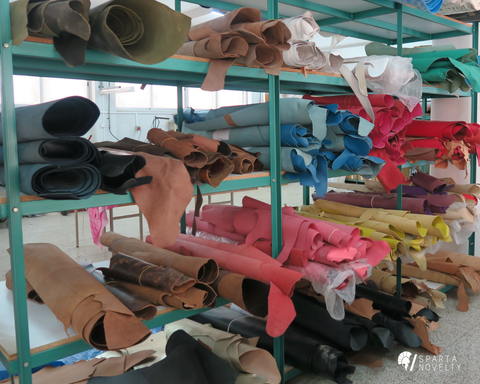April 23 2017 – Costas Ellinides

How To Spot Real Leather On Sandals
You might ask yourself why would you buy your summer sandals from Sparta Novelty. There are a lot of things that you might consider before buying sandals, the most important thing is for you to be able to spot real leather and fake leather.

Leather is often considered a staple in fashion. It’s not always easy to distinguish between faux leather and real leather on clothes and sandals. You can be frustrating to buy the looks of a genuine leather sandals only to realize it’s actually synthetic. Authentic leather is much more expensive than faux that’s why it’s important to tell the difference between the two.
You will be able to easily identify real and faux leather by mastering a few simple tips. Once you learn the difference your shopping experience will be enjoyable. Let’s dig deeper and have a look in details the difference between.
Real Leather
Genuine leathers are made from the skins of animals, such as cattle, goats, sheep and pigs. There are many types of leather but it can generally be categorized into three types; aniline, semi-aniline, and pigmented. When choosing which type of leather to purchase, consider the desired appearance, and how often the leather will be used.
Faux Leather
Faux leather is made from a fabric base, which is chemically treated with wax, dye, or polyurethane for a color and texture. Ultimately, it is manmade and exists to give the look and feel of real leather at an exceptionally lower cost. The most common type of faux leather is p leather. It is a plastic fabric made to look like leather. It is lighter and less restrictive than real leather, and can be dyed any color. Faux leather comes in many forms and some are better quality than others. Other types of faux leather include leatherette and vegan leather.

Spotting Faux Leather
The main differences between real and faux leather are the quality and durability. Spotting the difference between faux and real protected leather can be difficult because they can look very similar. There are several techniques that are used to identify faux leather.
Look at the Labels
It can sound obvious, looking at the label on the product is an easy way to identify the type of leather. Products made of real leather will proudly say so on the label, like we always say SPARTA NOVELTY — REAL LEATHER. If the label reads, “manmade materials,” the product is not made of real leather.
Examine the Pores
When making a leather purchase, closely examine the pores of the fabric. Faux leather will have pores that are in a consistent pattern, while real leather will have inconsistently placed pores.
Touch the Leather
Depending on the quality, real leather can feel coarse or smooth, or anywhere in between. Leather is also flexible and soft. If the item in questions feels really smooth or has a similar feel to plastic, it is likely fake leather. Faux leather also tends to stretch more than real leather. To become familiarized with the feel of real and faux leather, go to a reputable leather store and feel real leather to compare it to faux leather.
Smell the Item
Smell the object for the distinct leather smell. The smell of real leather cannot be replicated by synthetic materials. It may help to go to a department store and smell real leather items and faux leather items to become acquainted with the smell.
Comparing Real and Faux Leather
Real and faux leather have many different qualities. Each type has advantages and disadvantages. Consider several factors when making a leather purchase.
Advantages of Authentic Leather
There is nothing like the smell and feel of real leather. Real leather gives an aura of luxury and prestige. Because no two animal hides are exactly the same, each piece of authentic leather has unique natural characteristics. The leather becomes softer and more attractive over time, which makes it more comfortable. Leather also has a soft, yet strong texture, making it hard-wearing. Many real leather products are also treated to help prevent stains. Leather is easy to take care of when maintained properly; it only needs a regular wiping with a clean, damp cloth.
Disadvantages of Authentic Leather
Real leather is much more expensive than its counterpart. If leather is in constant sunlight, the color may fade. Leather is very porous and absorbent, so drops of liquid will quickly soak into the item if not wiped up promptly. If the leather is not protected, this can result in a stain.
Advantages of Faux Leather
None.
Disadvantages of Faux Leather
Faux leather has about a third of the life span of real leather. It cracks and splits much easier than real leather, and becomes more uncomfortable over time. It does not develop luster like real leather. Faux leather is very thin and does not offer the warmth of real leather. It also smells like plastic or rubber.
Health
The most important difference between real leather and faux leather is your health.
Tagged: real leather, summer sandals
